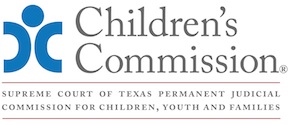
Texas Child Protection Law Bench Book
Updated September 2025
A. Definition of Human Trafficking
Commercial sexual exploitation of children, also known as human trafficking, is a term that refers to labor and sex trafficking of minors and adults. While all forms of trafficking are dangerous and exploitative, children and youth in foster care are especially vulnerable to child sex trafficking.
1. Federal Law
Under the federal Trafficking Victims Protection Act,[271] severe forms of trafficking in persons are defined as:
• Sex trafficking in which a commercial sex act is induced by force, fraud, or coercion, or in which the person induced to perform such act has not attained 18 years of age; or
• The recruitment, harboring, transportation, provision, or obtaining of a person for labor or services, through the use of force, fraud, or coercion for the purpose of subjection to involuntary servitude, peonage, debt bondage, or slavery. 22 U.S.C. § 7102(11).
The term “sex trafficking” means the recruitment, harboring, transportation, provision, obtaining, patronizing, or soliciting of a person for the purpose of a commercial sex act. 22 U.S.C. § 7102(12). A “commercial sex act” is defined as any sex act on account of which anything of value is given to or received by any person. 22 U.S.C. § 7102(4).
Special Issue: Force, fraud, or coercion are not required elements of sex trafficking when the victim is a child or disabled individual. In addition, geographic movement of the child is not required, and money need not be exchanged to prove a child was trafficked. Traffickers often manipulate children with promises of food, clothing, shelter, protection, and love. Children and youth cannot traffic themselves.
2. Trafficking of Children Defined
In Texas, “trafficking” is defined as transporting, enticing, recruiting, harboring, providing, or otherwise obtaining a person by any means. Tex. Penal Code § 20A.01(4).
For sex and labor trafficking offenses, a “child” is defined as a person younger than 18 years of age. Tex. Penal Code § 20A.01(1). Both child sex and labor trafficking are offenses in Texas regardless of whether the actor knew the age of the child at the time of the offense. Tex. Penal Code § 20A.02(b)(1).
3. Child Sex Trafficking
Texas law defines child sex trafficking as knowingly trafficking a child and by any means causing the trafficked child to engage in, or become the victim of, conduct prohibited by:
• Continuous Sexual Abuse of Young Child or Disabled Individual, Tex. Penal Code § 21.02;
• Indecency with a Child, Tex. Penal Code § 21.11;
• Sexual Assault, Tex. Penal Code § 22.011;
• Aggravated Sexual Assault, Tex. Penal Code § 22.021;
• Prostitution, Tex. Penal Code § 43.02;
• Solicitation of Prostitution, Tex. Penal Code § 43.021;
• Promotion of Prostitution, Tex. Penal Code § 43.03;
• Online Promotion of Prostitution, Tex. Penal Code § 43.031;
• Aggravated Promotion of Prostitution, Tex. Penal Code § 43.04;
• Aggravated Online Promotion of Prostitution, Tex. Penal Code § 43.041;
• Compelling Prostitution, Tex. Penal Code § 43.05;
• Sexual Performance by a Child, Tex. Penal Code § 43.25;
• Employment Harmful to Children, Tex. Penal Code § 43.251; or
• Possession or Promotion of Child Pornography, Tex. Penal Code § 43.26. Tex. Penal Code § 20A.02(a)(7).
Alternatively, a person commits the crime of child sex trafficking if that person knowingly receives a benefit from participating in a venture that involves an activity described by Tex. Penal Code § 20A.02(a)(7) or engages in sexual conduct with a child trafficked in the manner described in Tex. Penal Code § 20A.02(a)(7). Tex. Penal Code § 20A.02(a)(8).
The landmark case of In re B.W. addressed the issue of whether a thirteen-year-old child can be adjudicated a juvenile delinquent for committing the offense of prostitution. The Supreme Court of Texas held that a child under the age of 14 lacks capacity to consent to sex and thus cannot be charged with the offense of prostitution. The court found that, “[c]hildren are the victims, not the perpetrators, of child prostitution. Children do not freely choose a life of prostitution, and experts have described in detail the extent to which they are manipulated and controlled by their exploiters.” In re B.W., 313 S.W.3d 818, 826 (Tex. 2010).
Another defense to the offense of prostitution that the actor engaged in the conduct that constitutes the offense because the actor was the victim of conduct that constitutes an offense under Tex. Penal Code § 20A.02 or Tex. Penal Code § 43.05. Tex. Penal Code § 43.02(d).
Special Issue: Other terms referring to child sex trafficking include Commercial Sexual Exploitation of Children (CSEC), Commercial Sexual Exploitation of Youth (CSEY), Domestic Child Sex Trafficking (DCST), and Domestic Minor Sex Trafficking (DMST).
4. Child Labor Trafficking
In Texas, a person commits child labor trafficking by knowingly trafficking a child with the intent that the trafficked child engage in forced labor or services. Tex. Penal Code § 20A.02(a)(5). In addition, knowingly receiving a benefit from participating in a venture that involves an activity described by Tex. Penal Code § 20A.02(a)(5), including by receiving labor or services the person knows are forced labor or services, constitutes labor trafficking. Tex. Penal Code § 20A.02(a)(6).
“Forced labor or services” is defined as labor or services, other than labor or services that constitute sexual conduct, that are performed or provided by another person and obtained through an actor's use of force, fraud, or coercion. Tex. Penal Code § 20A.01(2).
Special Issue: Force, fraud, or coercion are required elements of child labor trafficking or adult labor or sex trafficking. Under Texas law, child sex trafficking can be accomplished by any means. Force, fraud, or coercion are not required.
5. Continuous Trafficking of Persons
A person commits the offense of continuous trafficking of persons if, during a period that is 30 or more days in duration, the person engages two or more times in conduct that constitutes an offense under Tex. Penal Code § 20A.02 against one or more victims. Tex. Penal Code § 20A.03(a).